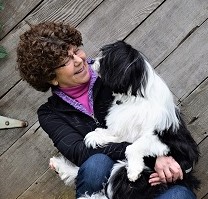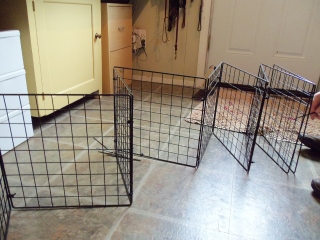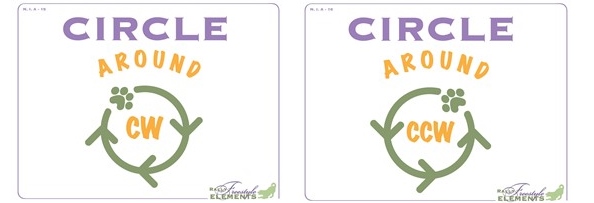Course Details
Rally-FrEe is a unique sport with the structure of a Rally course and the creativity of Musical Freestyle. To learn more about Rally-FrEe, please visit www.rallyfree.com
RA 501 is the first course of two foundation courses and is a pre-requisite for RA 502 Foundation 2. RA502 Foundation 2 is offered August 2020. It is recommended that both courses be completed. RA500 will also be accepted as a pre-requisite to RA502.
Each sport has its own set of foundation skills that allow the dog and handler to move more quickly and confidently through the training process of more complex skills.
For both Rally-FrEe and Freestyle, training transitions that include returning to a position are paramount to the team’s success. Transitions allow the dog and handler team to change position and/or direction without changing the dog’s flow of momentum.
We’ll focus on creating confidence and precision in foundation freestyle behaviors as well as creating clear and consistent criteria, often through the use of props or environmental management.
An important aspect of both Rally-FrEe and Musical Freestyle is placing behaviors on verbal cues and eliminating the need for hand cues. We’ll go step by step through the process of putting value and meaning into your verbal cues, preventing both dog and handler from becoming dependent on hand cues.
RA501 and 502 are great for anyone wanting to venture into the sports of Freestyle or Rally-FrEe but also for instructors considering adding Rally-FrEe or Freestyle to their class curriculum.
 Instructor: Julie Flanery
Instructor: Julie FlaneryJulie Flanery (she/her), CPDT-KA has been working professionally with dogs and their handlers since 1993. She focuses on the needs of the dog and helping people form a strong relationship, through clear communication, and positive reinforcement. She has placed Obedience...(Click here for full bio and to view Julie's upcoming courses)
Syllabus
Week 1: Lecture, Video and Exercises
- Transitions and Positions: what they are and why we need them
- Choice of methods – shape, lure or target?
- Teaching Stand
- Placing lured behaviors on verbal cue – “stand”
Week 2: Lecture, Video and Exercises
- Environmental management in shaping
- Circling the handler from left and right
- Placing shaped behaviors on verbal cue
- Placing circle behaviors on cue,
Week 3: Lecture, Video and Exercises
- Target Stick: How and Why
- Removing the gates for circles
Week 4: Lecture, Video and Exercises
- Spin to Position, CW and CCW
- Bow
Week 5: Lecture, Video and Exercises
- Placing spin on verbal cue, removing the target stick
- Getting started wit paw work
Week 6: Lecture, Video and Exercises
- Continue Paw work
- Thru to left Heel
- Thru to Right Heel
- Placing thru on verbal cue, removing props
Prerequisites & Supplies
Pre-requisites:
Students should be familiar with the use of markers, either a clicker or verbal marker and should understand the process of “shaping” or marking and rewarding small increments of behavior toward building the end result.
Dogs should have an understanding of markers and have the ability to focus on the handler during an exercise. And be able to maintain a standing, stationary position in left and right heel for a few seconds.
Equipment:
We’ll be using target sticks for some behaviors. Target sticks should be 14-18 inches long and have a distinct “target” at the end. If you don’t have a target stick, a household item may be used, such as a long wooden spoon or you can make one from a wooden or acrylic dowel and a foam practice golf ball. Target sticks can also be purchased online.
We will be using “training gates” to create clear criteria and eliminate the need for hand cues. These can be made from wire cube organizer panels (sold online or in-store), secured in lengths of 10 with zip-ties. Often you can find the wire panels used at thrift stores. One box of 6 cubes will net you two lengths of 10 panels. This is enough to cover the exercises in this course. You can also purchase online pre-made at the Rally-FrEe store: www.rallyfree.com/products
Very large dogs or dogs that may not respect barriers may use 18”-24’ Ex-pens. Small dogs under 14 inches may use “critter trail play pen” also found online. Or send an e mail to info@rallyfree.com to check availability of "small dog training gates"
Standing platforms are on option for some exercises. But only if your dog understands their value.
Please contact me if you have any questions regarding equipment.

Sample Lecture
WK 2: CIRCLES FROM LEFT AND RIGHT (CW AND CCW)
Circling the handler is a primary transition behavior. The circle behavior is also foundation in creating interesting variation behaviors for either Freestyle or Rally-FrEe. By building strength in the foundation, your variations will be easier and faster to train and you’ll have greater reliability and response from your dog.
The circle behavior should be taught in both directions, from the left and right side of the handler. In Rally-FrEe, the foundation circle behaviors are signs #15 and #16.

Note that they look very similar. The position the dog is in at the start tells you the direction they will travel. If the dog is in left heel he will travel clockwise. If he is in right heel he will travel counter-clockwise. You will never be "tricked" on a Rally-FrEe course. Your dogs position on approach to the sign indicates the direction of travel for the circle.
There are several other circle signs that add handler movement to allow the dog and handler team to change direction. We'll be working on at least one in this course, but most will be covered in foundation 2. Here is a link to all of the Rally-FrEe signs and their descriptions. Many of the signs are linked to vid clips of the behaviors.
http://www.rallyfree.com/rally-free-signs-2016/
If you haven't already, remember to download the Rally-FrEe app: search rallyfree (all one word lower case) in either Apple or Play Stores. It's free and will also give you video links to all of the skills covered in this class.
Some of you may be saying “but my dog already knows that behavior.” Before skipping steps, ask yourself a few questions and ask about both the clockwise circle from your left side and the counter-clockwise circle from your right side:
1) Does my dog always start and end in the same position?
2) Is it as fast as I would like?
3) Is it as tight as I would like?
4) Is my dog as responsive as I would like?
5) Does my dog show confidence and fluency?
6) Does my dog respond to a verbal cue without the aid of a hand signal?
By using the training gates to train the circle behavior, you now have an easy context without hand cues to train other behaviors (such as circling a cane or other prop) faster and with a greater degree of understanding in the dog.
Homework: Set up your training gates in a single, round circle, or pen. Make sure the circle is wide enough for you in the middle and your dog to move comfortably around you in a circle but not so wide that your dog can turn around. For most dogs a single gate will suffice, but for some large or giant breeds you may need to use two lengths of gates to create the appropriate size pen.
If your dog seems worried about the gates, walk him around the outside, as close as he seems comfortable, treating every couple of steps until you see him relax. Most dogs end up loving the gates and will often go into them on their own if left out after a session!
Some like to use a mirror to be able to see the dog even when he is moving behind you so if this is helpful to you set that up too. Mirrors are also a great aid in helping the handler maintain a straight posture, with hips and shoulders forward. In training many of these behaviors, but especially the circle behavior, you may have the tendency to want to “help” your dog through twisting or other body English. Work hard to avoid this as it will only hinder the dog’s ability to find value in your verbal cues.
With your dog on your left or right side (you’ll be training both, so choose which side you want to start with) walk into the round pen. As you enter, you'll need to turn so that you are facing the opening. If your dog is on your left, turn to your right. If your dog is on your right, turn to your left. Be ready to click. As soon as you move into the pen, your dog is likely to move forward. That is your first C/T. Place your reward about 2 inches in front of the dog. Don’t withhold it, but place it so your dog needs to take a small step or stretch of the neck to get it. This will help reinforce forward movement. While the dog is eating his first treat, you can close the pen.
Here is a clip of Sharon and Finn. This is their first lesson in the gates for circles. Notice the smallest movement forward earns c/t.
In this video you'll see me bring Dixie into the gates and get her started. Notice the fast food as I close the gates. This will give her a reason to stay in the gates and it allows me to close the gate without missing clickable movement.
Note there are no verbal or hand cues. When she stalls and there is no movement, I gently prompt her by placing my foot behind her. The goal is not to push her, but to take space away from behind her so she chooses to move forward. After the click I'm placing the food out ahead of her to get, to encourage more forward movement. Then you'll see her owner take over for the second session.
Stand straight, with your hips and shoulders squared and always facing the same direction. Again, avoid turning your body, or trying to lure with your hands, arms or shoulders. Look where you want the dog to go, rather than at your dog. Keep your criteria low at first, i.e. any single step or small movement forward earns a C/T.
In many cases, if your dog understands the C/T relationship, it will take only a few sessions for the dog to start to show confidence in moving in a complete circle around the handler. This of course, depends on your dog’s experience with shaping, the value of your reward and the comfort level of your dog in the gates, as well as the usual - timing of your marker and clean handler mechanics.
Be sure to read through the "Trouble Shooting for Circle Behaviors" document before you start. This will help you resolve some issues you may run into during the process.
This process applies to not only circling the handler but circling a cane, or other props as well. In the below video you'll see how a dog with understanding of circling the handler in the gates can learn quickly how to circle a cane without the use of hand signals, which means we don't have to take the time to eliminate them, we just add the verbal cue once we can predict the behavior. Feel free to try the below skill as well, but start with circling the handler in the gates for context.
When submitting your videos remember to show the whole dog and handler in your videos so that I can view not only the dog, but the handler as well. Okay! Let's go train! Remember to allow your dog to drive the process and most important have fun with this!
Testimonials & Reviews
A sampling of what prior students of Rally-FrEe and Musical Freestyle Foundations classes have said .....
Julie Flanery provides wonderful videos and description on how to progress with all rally free positions and transfer from either left or right side of the handler. plus very fun and easy to train all the tricks the way she shows each step. Greatly appreciated the class! Scout and I hope to show in rally free sometime soon.
Julie is an excellent instructor. WOW she has some great ideas to simplify training. Splitting behaviors down to the tiniest detail. Love it!
I enjoyed this class a lot and so did Heidi. The training gates that Julie uses to teach behaviors with precision are very helpful. Heidi comes running when the gates go up and doesn’t want to leave them. She loves the circles. Julie is always supportive with excellent comments and tips. The demonstration videos with her adorable and enthusiastic dog, Kashi, are inspiring! In this class there was a lot of communication among students. Forum discussions were lively and interesting. I am looking forward to taking more of Julie’s classes
I have to say - and wish I could make this 48pt size - of all the courses I've taken with FDSA, Julie Flanery has been the BEST INSTRUCTOR. Her feedback to the students is extremely good and well-stated and she is sensitive and kind. The lecture materials are complete and easily understood. I wish I had more thumbs to give her an adequate ThumbsUP....
Julie is simply wonderful! She was so clear and precise and I feel my training skills have improved greatly! I can't wait for her next class...
Julie Flanery is an outstanding training instructor who teaches Rally FrEe in very organized, detailed lectures with clear and concise videos and gives encouraging and precise feedback to the participants. Can't wait to take her next class. I'm moving up to Gold! Ellen S.
Julie is a terrific trainer. She understands the principles of operant conditioning and applies them consistently in her training. She is a joy to watch! Pamela L.
Julie is wonderful. She supports the class who submitted videos extremely well. As a person who did not submit videos I was able to watch and learn. It was interesting thtat she was talking about developing an eye to see what was wrong and how to fix it. I feel like that applied to me.
This class was amazing and Julie certainly gives absolutely stellar videos and feedback. Her eye for detail is amazing and I will absolutely continue learning with her whenever her classes are offered!
Registration
There are no scheduled sessions for this class at this time. We update our schedule frequently, so please subscribe to our mailing list for notifications.
Available as a prerequisite purchase (lectures only) for the August session to August 15.
RA501 Subscriptions
 Bronze |
||
|---|---|---|
| Tuition | $ 65.00 | |
| Enrollment Limits | Unlimited | |
| Access all course lectures and materials | ✔ | ✔ |
Find more details, refund policies and answers to common questions in the Help center.